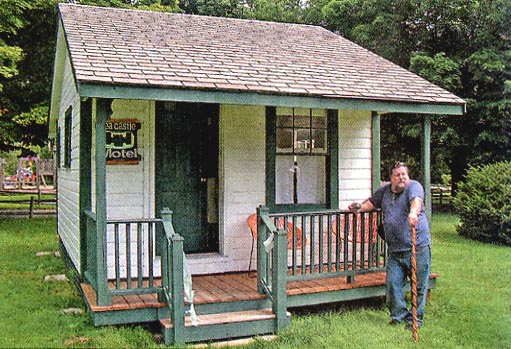Tuck Museum Unveils 1930s Tourist Cabin
By Patrick Cronin
Hampton Union, Tuesday, August 12, 2008
[The following article is courtesy of the Hampton Union and Seacoast Online]

[Patrick Cronin Photo]
HAMPTON — A 1930s tourist cabin that used to be a part of Young’s Cabins at Hampton Beach is the newest attraction at the Tuck Museum.
Members of the Hampton Historical Society unveiled the exhibit to the general public for the first time on Sunday, Aug. 10.
“This has been as few years in the making,” said Hampton Historical Society member Betty Moore.
The 20th century cabin joins the 1700s barn and 1900s school house on the museum grounds.
The cabin was officially opened after a ribbon-cutting ceremony, followed by a presentation by Historical Society member Bill Keating titled, “Early Hotels at Hampton Beach.”
Moore said officials first found out about the cabin in 2005 from Elizabeth Aykroyd, a member of the town’s Heri-tage Commission.
The cabin and other cabins that were part of the Sea Castle Motel and Cottages were slated to be demolished to make room for luxury condominiums. Aykroyd said the Heritage Commission signs off on all demolition permits and was able to convince the developer to allow the museum to take ownership of the cabin.
“This is one of the last tourist cabins on the beach,” Moore said. “It’s a unique part of 20th century Hampton history that’s worth preserving.”
The cabin was built by Hamblet Young in 1930. A later owner from Manchester by the surname of Lomazzo operated the property as Young’s Motel in the 1950s, in addition to running the Hollywood Motel and a restaurant.
Aykroyd said the cabin is what you would have seen all over around beach in 1930s.
“This was absolutely typical of what was at the beach from 1920 and into 1950s,” she said.
Moore said they were able to move the cabin to the museum grounds with the aid of former selectman and Budget Committee member Michael Plouffe. He donated his time and a flatbed to move the cabin from Ocean Boulevard to Park Avenue.
What transpired next was a two-year effort to get the cabin ready for exhibit. Officials spent the first year working on the exterior and this summer, they on the interior of the cabin.
“We tried to make the cabin as it would have been like in the 1950s,” Moore said.
The cabin features original linoleum flooring and original pine kitchen seating area and combination sink/stove/refrigerator from the 1950s. Volunteers donated items such as a bathing suit and dress from the 1950s to give the cottage a nostalgic feel.
An old bed that was in the attic of the museum was put inside the cottage and Ann Carnaby made curtains to go over the window.
“We also have an old coke bottle opener that was used back then,” Moore said. “As we go along we would like to keep adding things to the cabin.”
Moore said one of the reasons it took so long to get the cabin open is because society members got caught up in the restoration of the 1700s barn.
“I think its going to be fun for people to see what it was like staying at Hampton Beach in the 50s,” Moore said. “It does tell a story of Hampton Beach that is almost gone.”